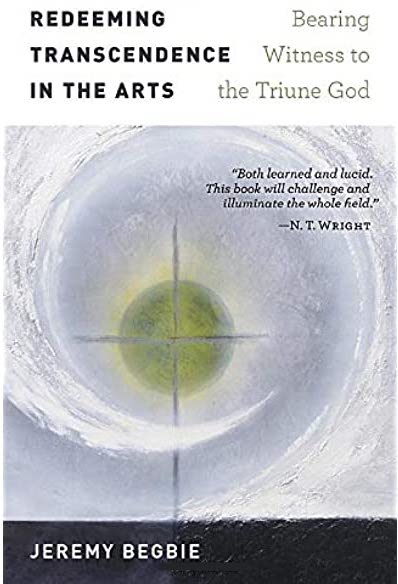Editor’s note: this review originally appeared in the Winter 2020 issue of the Concordia Journal. We reprint it here in anticipation of this year’s Theological Symposium, “Whatever is Lovely”: The Role of Beauty in Theology and Ministry, September 21-22, 2021. For more information and to register, go to https://www.csl.edu/resources/continuing-education/theological-symposium/.
 REDEEMING TRANSCENDENCE IN THE ARTS: Bearing Witness to the Triune God. By Jeremy Begbie. Eerdmans, 2018. Paper. 212 pages. $18.00.
REDEEMING TRANSCENDENCE IN THE ARTS: Bearing Witness to the Triune God. By Jeremy Begbie. Eerdmans, 2018. Paper. 212 pages. $18.00.
Some books are definitive for their topic and others are exploratory, inviting scholars to pursue lines of thought that will bring both discovery and clarification to a field. Jeremy Begbie’s Redeeming Transcendence is definitely an exploratory book.
In this work, Begbie seeks to revitalize Christian engagement in conversations about the intersection of theology and the arts. As professor of theology at Duke Divinity School, director of the Duke Initiatives in Theology and the Arts, and an accomplished musician, Begbie writes from a profitable intersection of theological acumen and artistic sensitivity.
Begbie’s work follows a helpful dialogical pattern. He begins by listening to how Christians use the language of transcendence as they discuss theology and the arts; then, he turns his attention to the Scriptures to hear how God has equipped the church to contribute to this conversation; and, finally, he closes by offering a series of examples wherein
the church can speak into conversations about the arts, bringing its specific witness of the Triune God in a way that redeems discussions of transcendence in the arts.
In the first two chapters, as Begbie listens to conversations about theology and the arts, he focuses his attention upon the elusive language of “transcendence” and the “sublime.” He offers a general survey of specific scholars and artists, situates their arguments through careful footnotes, and creates a helpful balance of the literary, visual, and musical arts. In this general overview, Begbie notes the following points of agreement in references to the “transcendent”: the arts give people the sense of divine transcendence; this sensibility is best cultivated in the absence of explicitly religious content; the transcendent experience affirms God’s presence in the world apart from the ways in which God is normally recognized by religious traditions; and, because of this, the arts offer a way for the church to interact with a culture that is skeptical and increasingly disillusioned, if not downright hostile, to the faith.
As Begbie reflects upon the contours of this conversation, he notes how this discussion often assumes that divine transcendence is discovered from an interaction with our limits (rather than an interaction with the divine), how it works with a generalized or generalizable deity (rather than the God revealed in Jesus Christ and attested to by scriptural witness), how humans are assumed to be able to perceive and respond to experiences of transcendence (rather than needing to repentant and be changed for such an experience), and how the divinity expressed is often of a unitarian (not Trinitarian) nature.
In the third chapter, as Begbie turns to Scripture, he meditates upon the Gospel of John and allows the self-revelation of God in Jesus Christ to serve as the source for a renewed understanding of the transcendent.
Rather than base our understanding of the transcendent upon the limits of our experience, Begbie articulates a Christian understanding of the transcendent based on the revelation of Jesus Christ. In particular, Begbie highlights how the Trinitarian relationship articulated in John offers a pattern for how Christians might speak about God in reference to “otherness” and “uncontainability,” both qualities that typify discussions of the “transcendent.”
In terms of “otherness,” the Christian faith confesses God’s otherness as a dynamic otherness that is “to and for the world” (131). Rather than see God’s otherness through the lens of our limits wherein transcendence is often distanced or detached, we begin to see God’s transcendence as “characterized by a loving commitment to the integrity and fullness of the other” (130). In terms of “uncontainability,” Begbie argues that the Christian faith confesses God’s uncontainability as an “outward movement of self-sharing for the sake of the other” (155). Rather than see God’s uncontainability through the lens of the created order (wherein the transcendent is an abstraction from our limits (e.g., eternal rather than contained in time and infinite rather than contained in space), we begin to see God’s uncontainability as characterized by his faithful creative acting out of covenant love.
In the fourth chapter, Begbie then explores the implications of his work with the Scriptures. He returns to the earlier conversation about the transcendent and demonstrates with concrete examples the way in which bearing witness to the Triune God shapes our conversations about the transcendent in the arts. Here, his work is the most fascinating and, unfortunately, due to space, the most limited. The examples he does offer, however, tangibly show the way in which Christian conversation about the “transcendent” in the arts is revitalized by a meditation upon the Scriptures and what we, as Christian, have been given to say.
Because the book is exploratory and not definitive, Begbie offers scholars a quick glance at the impoverished way in which the church engages in conversations about theology and the arts and a sound and invigorating way forward for future conversations. His work, therefore, opens up avenues for future scholarship and, while not definitive, will serve as the starting point for richer and robust conversations that engage scriptural witness and the world in conversations about theology and the arts.
David Schmitt


Leave a Reply
You must be logged in to post a comment.